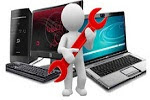Everything You Need to Know About Computer Hardware
Computer hardware refers to the physical components that make up a computer system.
There are many different kinds of hardware that can be installed inside, and connected to the outside, of a computer.
Computer hardware may sometimes be seen abbreviated as computer hw.
:max_bytes(150000):strip_icc():format(webp)/computer-hardware-2625895-final-v1-8c909b8a32434e26a225db2314823bb2.jpg)
Take a tour inside a desktop computer to learn how all the hardware in a traditional desktop PC connects together to create the complete computer system like the one you may be using right now.
List of Computer Hardware
Here are some common individual computer hardware components that you'll often find inside a modern computer. These parts are almost always found inside the computer's housing, so you won't see them unless you open the computer:
- Motherboard
- Central Processing Unit (CPU)
- Random Access Memory (RAM)
- Power Supply
- Video Card
- Hard Drive (HDD)
- Solid-State Drive (SSD)
- Optical Drive (e.g., BD/DVD/CD drive)
- Card Reader (SD/SDHC, CF, etc.)
Here is some common hardware that you might find connected to the outside of a computer, although many tablets, laptops, and netbooks integrate some of these items into their housings:
- Monitor
- Keyboard
- Mouse
- Battery Backup (UPS)
- Flash Drive
- Printer
- Speakers
- External Hard Drive
- Pen Tablet
Here are some less common individual computer hardware devices, either because these pieces are now usually integrated into other devices or because they've been replaced with newer technology:
- Sound Card
- Network Interface Card (NIC)
- Expansion Card (Firewire, USB, etc.)
- Hard Drive Controller Card
- Analog Modem
- Scanner
- Projector
- Floppy Disk Drive
- Joystick
- Webcam
- Microphone
- Tape Drive
- Zip Drive
The following hardware is referred to as network hardware, and various pieces are often part of a home or business network:
- Digital Modem (e.g., Cable Modem, DSL Modem, etc.)
- Router
- Network Switch
- Access Point
- Repeater
- Bridge
- Print Server
- Firewall
Network hardware isn't as clearly defined as some other types of computer hardware. For example, many home routers will often act as a combination router, switch, and firewall.
In addition to all the items listed above, there's more computer hardware called auxiliary hardware, of which a computer might have none, or several, of some kinds:
- Fan (CPU, GPU, Case, etc.)
- Heat Sink
- Data Cable
- Power Cable
- CMOS Battery
- Daughterboard
Some of the devices listed above are called peripheral devices. A peripheral device is a piece of hardware (whether internal or external) that isn't actually involved in the computer's main function. Examples include a monitor, video card, disc drive, and mouse.
Troubleshooting Faulty Computer Hardware
Computer hardware components individually heat up and cool down as they're used and then not used, meaning that eventually, every single one will fail. Some may even fail at the same time.
Fortunately, at least with desktop computers and some laptop and tablet computers, you can replace the non-working piece of hardware without having to replace or rebuild the computer from scratch.
Here are some resources you should check out before you go out and purchase a new hard drive, replacement RAM sticks, or anything else you think may be going bad:
Memory (RAM)
- Free Memory Test Programs
- How Do I Replace the Memory (RAM) in my Computer?
Hard Drive
- Free Hard Drive Testing Programs
- Commercial Hard Drive Testing Tools
- How Do I Replace a Hard Drive?
- What to Do When Your Hard Drive Is Making Noise
Computer Fan
- How to Troubleshoot a Noisy Computer Fan
In Microsoft Windows, hardware resources are managed by Device Manager. It's possible that a "faulty" piece of computer hardware is really just in need of a device driver installation or update, or for the device to be enabled in Device Manager.
Hardware devices won't work at all if the device is disabled, or may not be running properly if the wrong driver is installed.
- How Do I View a Device's Status in Device Manager in Windows?
- How Do I Enable a Device in Device Manager in Windows?
- How Do I Update Drivers in Windows?
- Where Can I Get Free Driver Downloads?
- Free Driver Updater Tools
If you decide that some hardware needs replacing or upgrading, find the manufacturer's support website for warranty information (if it applies to you) or look for identical or upgraded parts that you can buy directly from them.
See these hardware installation videos for walkthroughs on installing different computer hardware, like a hard drive, power supply, motherboard, PCI card, and CPU.
Hardware vs Software
A computer system isn't complete unless there's also software, which is different than hardware. The software is data that's stored electronically, like an operating system or a video editing tool, which runs on the hardware.
Hardware gets its name due to the fact that it's strict when it comes to modifications, whereas software is more flexible (i.e., you can easily upgrade or change software).
Firmware is closely related to hardware and software, too. Firmware is used to tie the two together so that a software program knows how to interface with a piece of hardware.



No comments